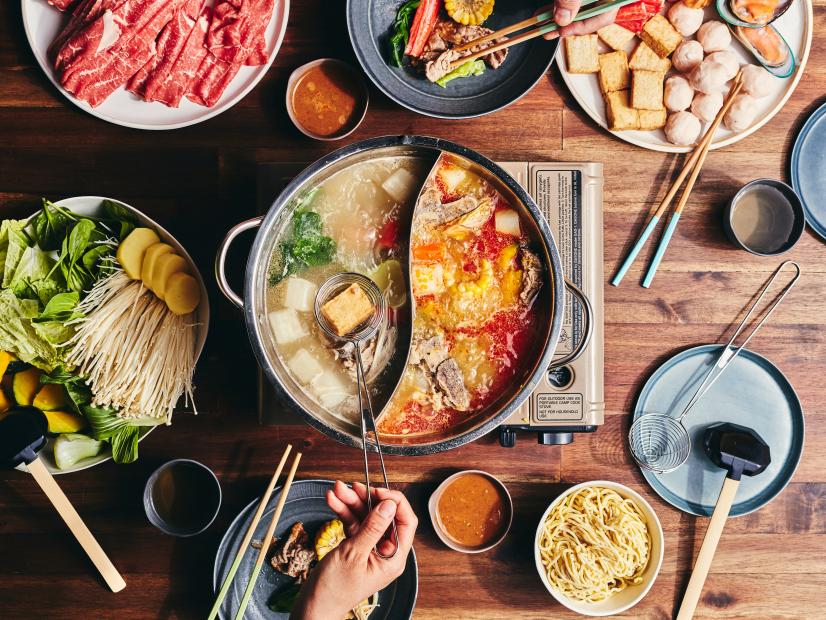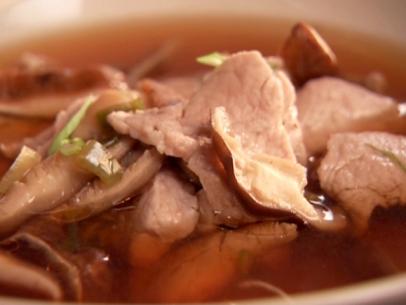
Hot Pot at Home
- Level: Easy
- Total: 3 hr 15 min
- Active: 45 min
- Yield: 4 servings
- Level: Easy
- Total: 3 hr 15 min
- Active: 45 min
- Yield: 4 servings
Ingredients
Pork Broth:
Components:
Condiments (pick whichever ones you like):
Hot Pot Dipping Sauce:
Directions
Special equipment:
an 11-inch hot pot pot with a divider that splits the pot into 2 sections, portable butane burner, butane, small (2.5 to 3-inch) hot pot strainers- For the pork broth: Fill a 7-quart Dutch oven with 12 cups cold water and bring to a boil. Meanwhile, soak the pork bones in cold water in a large bowl, to remove some of the blood, for about 20 minutes or until the water boils. Add the bones to the pot and boil until the water darkens and there’s a lot of foam on the surface, about 8 minutes. Drain and rinse the bones and clean the pot of any residue.
- Return the pork bones to the pot and add the carrots, corn, daikon and 16 cups cold water. Bring to a boil over high heat and then reduce the heat and simmer, covered, until the broth is very milky, about 2 1/2 hours. Skim off any dark proteins and fat, then lightly season with salt.
- Transfer the pork broth, along with the bones and other solids, which will continue to flavor the broth, to an 11-inch hot pot pot with a divider. Add the chili oil to one side of the pot. Place the pot on a portable butane burner and bring to a boil over high heat.
- For the components: Meanwhile, arrange the beef, fish, cabbage, spinach, potatoes, pumpkin, eggs, fish tofu and udon noodles on plates or platters, as you like. Set out at least two pairs of chopsticks or tongs and small strainer baskets (these are useful when cooking more fragile ingredients, such as fish, tofu and the like). As for the chopsticks/tongs, let everyone know not to use the same pair for picking up raw and cooked meat and fish.
- For the condiments: Create a “dipping sauce station” with any of the condiments, along with a bunch of small plates and bowls. Each person can mix and match them as they like.
- Once the broth is boiling, start cooking! Let each person cook their own ingredients in the broth (the side with the chili oil is spicier), being mindful not to overcrowd the pot. If the broth reduces too much and you still have raw ingredients left, add some warm water to the pot and bring to a boil. If you like, you can eat the marrow from the pork bones.
More Components to Try:
- Proteins–Thinly sliced chicken, pork or lamb, mini-pork sausages, low-sodium luncheon meat cut into 1/2-inch-thick slices, shellfish, fish cakes, tofu
- Vegetables–sweet potato, kabocha squash, watercress, bok choy, corn on the cob, lotus root, kale, chile peppers, tomato, bean sprouts, enoki, shiitake or button mushrooms
- Noodles, etc.–ramen noodles, rice noodles, konjac noodle knots, dumplings, rice cakes, dried tofu sticks
Hot Pot Dipping Sauce:
- Stir together the Pork Broth, BBQ sauce, sesame paste, oyster sauce, soy sauce, hoisin sauce, sesame oil, sugar, garlic and scallions in a small bowl until combined.
Cook’s Note
For the beef, we recommend using a fatty cut, such as brisket or ribeye. Asian stores sell pre-sliced meat for hot pot cooking; look for packages labeled “beef for hot pot” or “pastrami beef”.

































